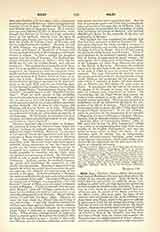

Gillespie, (I) ELIZA MARIA (in religion Mother MARY OF ST. ANGELA), b. in Washington county, Pennsylvania, February 21, 1824; d. at St. Mary’s convent, Notre Dame, Indiana, March 4, 1887. She was the daughter of John Purcell Gillespie and Mary Madeleine Miers, the latter a convert to the Church. After her husband’s death, Mrs. Gillespie in 1838 went with her three children to her former home, Lancaster, Ohio. Eliza Maria first attended the school of the Dominican sisters at Somerset, Ohio, and completed her studies at the Visitation Convent at Georgetown, D.C., in 1844. Her kinsman, Thomas Ewing of Ohio, was then eminent in public life, and this fact, joined to her beauty and accomplishments, made her at once a prominent figure in the social life of Washington and of Ohio. Her sympathy was roused by the sufferings of the Irish people during the famine, and she and her cousin, Eleanor Ewing, by their joint efforts, collected and here she met Rev. Edward Sorin, provincial of the Congregation of the Holy Cross in the United States, through whose influence she was led to cast her lot with this small and struggling community. She received the religious habit in 1853, taking the name of Sister Mary of St. Angela. She was then sent to France, where she made her novitiate at the convent of the Sisters of Bon Secours, at Caen, making her religious profession by special dispensation December 8, 1853, at the hands of Very Rev. Father Moreau, the founder of the congregation.
In January, 1855, Sister Angela returned to America and was made superior of St. Mary’s Academy at Bertrand, Michigan. On August 15, 1855, she transferred the academy to its present location near Notre Dame, Indiana, and procured for it a charter from the Indiana legislature. When the Civil War broke out Mother Angela organized a corps of the Sisters of the Holy Cross to care for the sick and wounded soldiers. She established hospitals, both temporary and permanent, and, when generals failed to secure needed aid for the sick and wounded, she made flying trips to Washington on their behalf. Her headquarters were at Cairo, Illinois, in ill-provided buildings. The close of the war left her physically enfeebled, but she returned to St. Mary’s and resumed her educational work, and compiled two series of readers for use in Catholic schools, the “Metropolitan” and “Excelsior”.
In 1869, at the advice of Bishop Luers of Fort Wayne, the Sisters of the Holy Cross in the United States determined on a separation from the members of the congregation in France. This was effected, with Mother Angela as superior of the new community. Under her rule thirty-five institutions were founded throughout the United States, among them St. Cecilia’s and Holy Cross Academies, Washington, D.C.; St. Mary’s Academy, Salt Lake City, Utah; St. Mary’s Academy, Austin, Texas; St. Catherine’s Normal Institute, Baltimore, Maryland; and Hawke’s Hospital, Mt. Carmel, Columbus, Ohio. Mother Angela was the moving spirit in the establishment in 1865 of the “Ave Maria”, to whose pages she made many contributions. On flaying down the burdens of her superiorship, Mother Angela was chosen mistress of novices at St. Mary’s, and in September, 1886, she was again made the head of St. Mary’s Academy, at which post she remained until her death.
(2) NEAL HENRY GILLESPIE, brother of the foregoing; b. in Washington county, Pa., January 19, 1831; d. at St. Mary’s, Notre Dame, Indiana, November 12, 1874. He was one of the first students of the University of Notre Dame, Indiana, and in 1849 received the first degree conferred by that institution. On September 1, 1851, he entered the novitiate of the Congregation of the Holy Cross at Notre Dame, Ind., made his religious profession August 15, 1853, and was ordained priest June 29, 1856, at Rome, where he had been sent to complete his theological studies. Returning to America, he filled the post of vice-president and director of studies at Notre Dame (1856-59), and then was appointed president of the College of St. Mary of the Lake, Chicago, Illinois. In 1863 he was called to the motherhouse of the congregation at Le Mans, France, where he remained until 1866. He then returned to Notre Dame, and assumed the editorship of the “Ave Maria”, which position he filled until his death. In addition to his editorial labors, he was a frequent contributor to its pages, as well as to many other Catholic periodicals.
JOHN G. EWING

